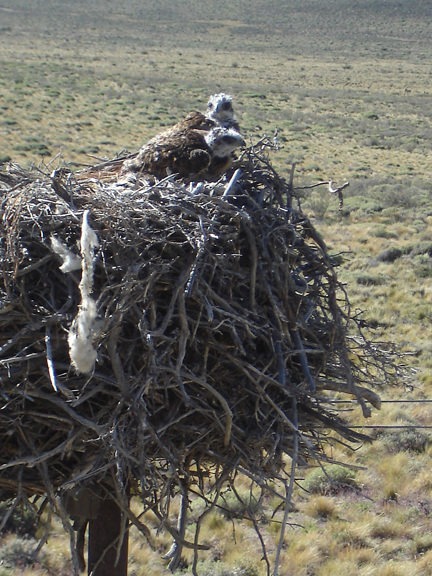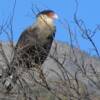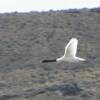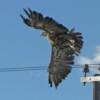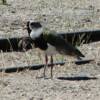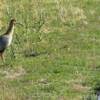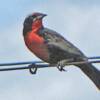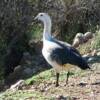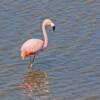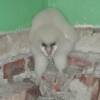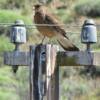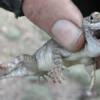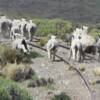An Andean Condor (above) soars under an afternoon moon. Left, two unidentified raptor chicks wait for their meal. Below, vultures resting after feasting on a animal carcus.
Dick Smart
"One of the more interesting animals that we encountered along the La Trochita were the rheas," writes Dick Smart. "These ostrich-like birds are extemely fast and very difficult to photograph. Our most memorable encounter with these creatures occurred near Lepa station after we had crossed our first range of mountains. I was riding in front, and we were pedaling down hill at a rapid clip.
"I noticed off to my right a large adult rhea performing what I would describe as the broken wing ritual that a mother killdeer uses to attract a predator's attention toward her and away from her young chicks. This is where the analogy ends, however. The wings on these critters are huge!
"In my photograph to the right you can barely see what looks like a flying Hereford out in the field on the right side of the picture. This is the adult rhea. Glancing straight ahead I could see at least fifteen little rheas, running between the rails. Peter was riding behind me and shot the photo below using a telephoto lens.
"Because our hands are as busy as our feet, it is nearly impossible to take a photo at high speed from a railbike. Note that I am frantically turning the leveling control knob as I approach the left hand curve at high speed (15mph).
"Enough was enough! Aware of their fright, we braked and watched from a distance as the father rounded up his brood. Yes, I said father. A rhea cock is a one-nest polygamist who I would classify as a super dad. He digs the nest, sits on the eggs (as many as fifty) and takes care of all those chicks!!"
"Everything that we brought to South America is on board our railbikes including our suitcases. A derailment would not be good! As I caught up to the baby rheas the scene turned comical. Their skinny little legs were a blur of motion moving at times faster than what their youthful coordination would allow. Ever so often one of them would trip and tumble clumsily into a rolling somersault followed by a awkward landing and recovery.
Click on the photos below for some additional sightings.
Railbike Wildlife
Part V Continued
Dick Smart
At right, a raptor on a
telephone pole keeps an
eagle eye on Arne
as he rides through a small cut.
Note the comparison between man and bird and you get an idea of the raptor's size.


